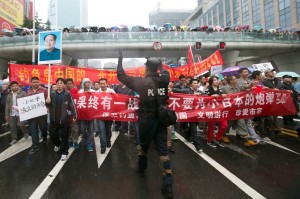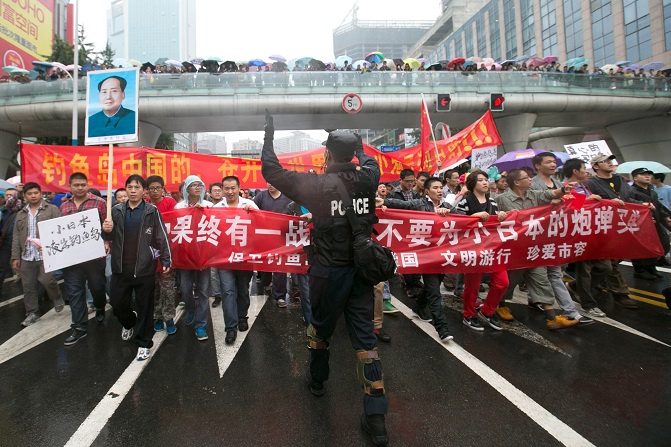
AFP PHOTO
Joel Gulhane
Three days after being admitted to hospital, Japan’s newly appointed ambassador died on Sunday morning from an unspecified illness, further complicating the China-Japan island strife, reported the Associated Press.
Meanwhile, protests against the Japanese territorial claim and pending purchase of the uninhabited islands in the East China Sea have continued across China with reports of some turning violent. Security has increased around the Japanese embassy following the escalation of the protests and a call from the Japanese Prime Minister for Beijing to guarantee the security of Japanese property and citizens in China.
Demonstrations are an unusual sight in China but protests have erupted nationwide on this issue. The disputed Islands are known in Japanese as “Senkaku” and in Chinese as “Diaoyu” and are also claimed by Taiwan. The islands are located near to gas deposits and in key shipping lanes, according to the BBC. On Saturday, a statement on the People’s Daily Online, the online version of the Communist Party’s newspaper, warned Japan to “pull back before it is too late… otherwise it will pay an even heavier price.”
The protests were mainly peaceful but there were reports of violence. According to Associated Press, Guangdong Province security forces fired tear gas into the crowds in Shenzhen, with protestors throwing the canisters back. In the capital of the province, Guangzhou, it is thought that the protest was as large as 10 000 and some protestors caused damage to the Japanese consulate and a Japanese restaurant. Several people were detained by police for damaging property. Reports say Japanese businesses such as Toyota and Panasonic have also been targeted.
In Shenzhen, a photographer for the South China Morning Post (SCMP), Felix Wong, accused police of using excessive force upon him despite identifying himself as a reporter. The SCMP editor has confirmed that an official complaint will be made to the Shenzhen authorities.
In Beijing, according to Associated Press, the police controlled the protest by only allowing groups of 100 to march past the embassy at a time. Similar scenes occurred in Shanghai, the demonstrations were smaller and police were managing them carefully, allowing only groups of around 50 people to protest for 5-10 minutes before moving them away.
Protests were also seen outside of China, with hundreds of Chinese-Americans turning out to demonstrate in San Francisco’s Chinatown district.
Associated Press has also reported that in an attempt to reduce the spread of the unrest the Chinese government has restricted the internet search term ‘anti-Japan protests’ on a Twitter-like website. It has also deleted videos posted of demonstrations from the internet. Regardless of this, the Chinese Foreign Ministry spokesman stated on Saturday that the Chinese government advocates Chinese citizens protesting within the rule of law, according to the Xinhua news agency.
According to Associated Press, US Defense Secretary Leon Panetta has expressed his fears over the situation worsening, stating, “What we don’t want is to have any kind of provocative behaviour on the part of China or anybody else result in conflict.” Mr Panetta was speaking before undergoing a trip which will take him to both Japan and China in the next few days.
With elections in Japan and China’s ruling Communist Party having a reshuffle, both countries may choose to show strength to their respective publics. It appears that the protests will continue across China unless Japan stalls its attempt to purchase the islands and returns to the negotiating table.




